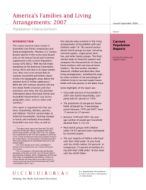America's Families and Living Arrangements: 2007
America's Families and Living Arrangements: 2007
INTRODUCTION
This report presents basic trends in household and family composition and living arrangements. Previous U.S. Census Bureau reports in this series were based only on the Annual Social and Economic supplement to the Current Population Survey (CPS ASEC). With the full implementation of the American Community Survey (ACS) and due to its large sample size, there now exist annual data to examine household and family characteristics for geographic areas below the national level (3 million addresses). While the CPS contains detailed information about family structure and characteristics over time, the ACS provides information about how basic family and household characteristics vary across geographic areas, such as states and counties.
This report is organized into four sections: households, families, parents, and children. The first section looks at America’s households, tracking changes in family and nonfamily households, household size over time, as well as the state-by-state variation in the living arrangements of households with own children under 18. The second section details family groups by type, including married couples, single-parent families, and other family groups. The third section looks at America’s parents and compares the characteristics of stay-at-home mothers with non-stay-at-home mothers. The last section considers America’s children and describes their living arrangements, including the state-by-state variation in the percentage of children living in married-couple households with two parents in the labor force.
Some highlights of the report are:
• Sixty-eight percent of households in 2007 were family households, compared with 81 percent in 1970.
• The proportion of one-person households increased by 10 percentage points between 1970 and 2007, from 17 percent to 27 percent.
• Between 1970 and 2007, the average number of people per household declined from 3.1 to 2.6.
• Most family groups with children under 18 (67 percent) were maintained by married couples.
• The vast majority of fathers who lived with their child under 18 also lived with the child’s mother (94 percent). In comparison, 74 percent of mothers living with their child under 18 also lived with the child’s father.
• Stay-at-home mothers were younger and had younger children than other mothers.
• Stay-at-home mothers were more likely to be Hispanic than non-stay-at-home mothers. Stay-at-home mothers were more likely to be foreign born than non-stay-at-home mothers.
• Among children living with a parent, younger children were more likely than older children to live with two unmarried parents. So, while 10 percent of infants under age 1 lived with two unmarried parents, 1 percent of children 12 to 17 lived with two unmarried parents.
• Among children living with unmarried parents, older children were more likely than younger children to live with their father only, with no other adult present. Only about 2 percent of children under 3 lived with their father who was the sole adult, while 11 percent of teens 12 to 17 did.
Others in Series
Publication
Publication
Publication




